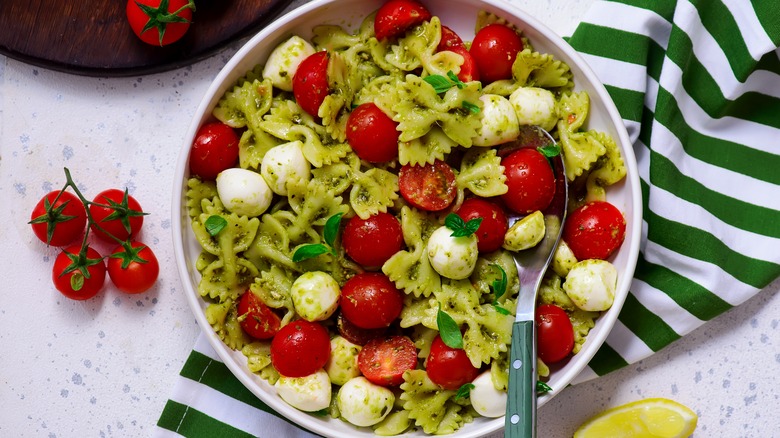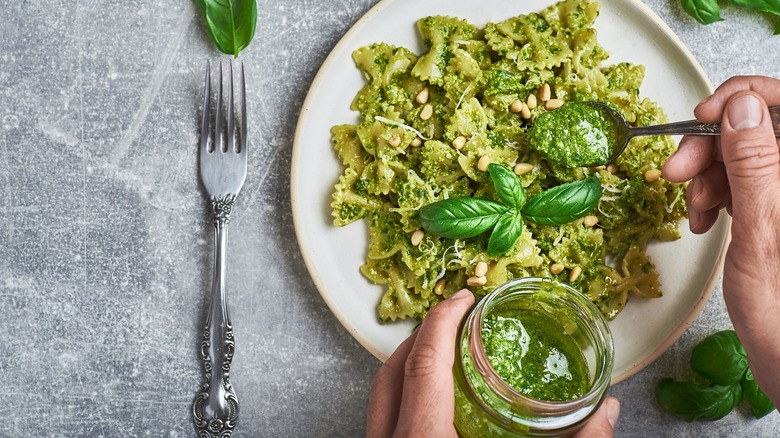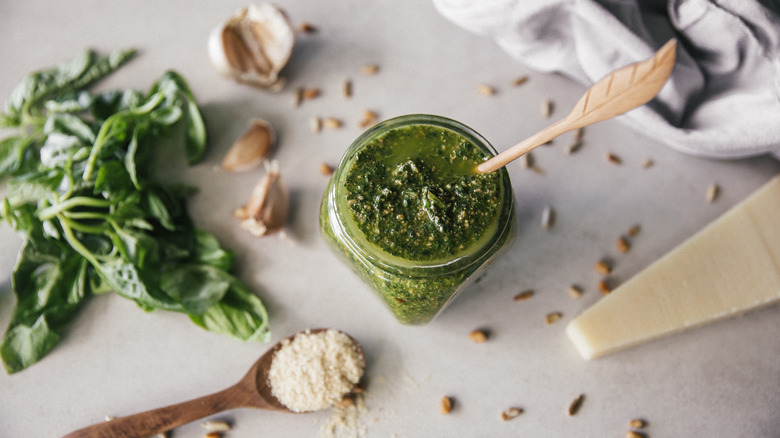There's A Right And Wrong Way To Turn Pesto Into Pasta Salad Dressing
Pesto pasta is a classic combination. While it's often served hot and with a side of garlic bread, turning pesto into a dressing for cold pasta salad is another simple way to enjoy this tasty pairing. Perfect for potlucks and backyard barbecues, pasta salad is a staple side. Whether you keep it light with tangy feta, crispy red onions, and refreshing cucumbers, or give it a Caprese-style twist with juicy cherry tomatoes, fragrant basil, and creamy mozzarella, the delicious dish is easy to make ahead of time. And although pasta salad is typically dressed with a vinaigrette or a mayonnaise-based sauce, putting pesto in the dressing is a great way to enhance it with nutty and herbaceous flavors.
As with any dish, though, it's possible to make mistakes when preparing pasta salad. There's a right and wrong way to add dressing, especially when pesto is involved. Aptly named for its crushed ingredients, the classic, summery Italian condiment is surprisingly sensitive considering the brute force required to make it. As it turns out, two of pesto's star ingredients — olive oil and basil — don't hold up well when exposed to heat. While you should never dress your pasta salad while it's still hot as this could lead it to become soggy, it's important to avoid doing so with a pesto-based dressing specifically. Otherwise, the dish might turn an unsavory shade of brown instead of vibrant green and won't taste nearly as good. Here's what you should know to prevent this culinary faux pas.
Avoid adding a pesto-based dressing to hot pasta
Since pesto is often spooned onto hot pasta, from gnocchi to penne, it might seem nonsensical that you shouldn't add it to noodles fresh off the stove. However, unlike marinara or Alfredo, the sauce won't look or taste its best after being exposed to high heat. As a fairly fragile herb, basil begins to lose its bright color and flavor when it's cooked, which breaks down the cell walls of the fresh leaves. This can cause the sauce to brown and develop a more muted, sometimes unpleasant flavor. (Ever noticed leftover pesto change color, even in the fridge? That's because crushed basil's broken cells are oxidizing — a process which you can slow with a simple olive oil storage hack.)
So, before adding a pesto-based dressing to pasta salad, make sure to always let the pasta cool first. Leaving it to sit in the strainer until it comes down to room temperature should do the trick. But there are other ways to speed the process along, too. For instance, you can quickly cool pasta for pasta salad with a sheet pan; simply spread the noodles out across the large surface area, allowing the air to reach them more evenly. No matter what, though, you should never cool pasta by rinsing it under cold water after it cooks, as this can harden it and wash away any starch that would otherwise help the dressing stick to each piece.
How to thin pesto for the perfect dressing consistency
It can be deceptively tricky to achieve the right consistency when whipping up pasta salad dressing. Too thin and runny, it may not stick to the noodles at all — even if you're using spiral-shaped fusilli, which is well-regarded for trapping sauce in its curves. Too thick and it might not coat the pieces of pasta or other chopped ingredients evenly (let alone infuse them with the rich flavor), no matter how much you toss the dish. Dealing with hot pasta can only make matters worse, as high temperatures may thin out the dressing even more — another reason to always let the noodles cool first.
Since pesto tends to be on the thicker side, as far as condiments go, you may need to thin it to transform it into a proper salad dressing. The best way to do so is by adding some sort of cool liquid to the sauce. The exact one you choose may depend on the type of dressing you're making. To stay true to pesto's ingredients, you could stir some more olive oil into it. If you're looking to keep the dressing on the lighter side and don't want to strengthen its flavor, a little water will do. Alternatively, if you prefer the condiment more savory, consider using chicken or vegetable stock. Whichever option you choose, so long as you add your pesto-based dressing to cool noodles, your pasta salad will turn out appetizing for all the senses.


